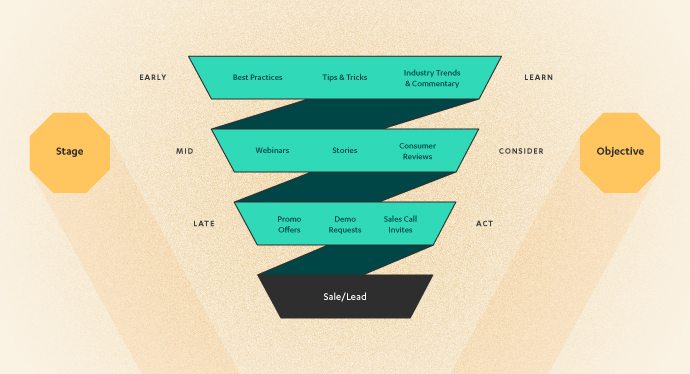January 27, 2017
Content Marketing Strategy Framework
What’s the secret to getting results with content marketing? Starting with a thoughtful strategy. In this article, you’ll learn:
- Content marketing’s primary objectives
- How to pick from the smorgasbord of content types
- What to send during every stage of the lead nurturing content funnel
There’s way more to cover when creating a fully fleshed out content marketing strategy, but these elements will give you a solid kickstart. Let’s hop in.
Content marketing’s primary objectives
Content marketing’s main objectives are to get found and to educate.
Getting found
Time for a pop quiz: which of these has a better chance of bringing in a new lead? A) Sending a cold email to a prospective customer B) Writing a blog post that solves a common customer problem Most marketers would answer A, if it were 1995. Today the answer is resoundingly B. Companies who blog generate 126% more leads, increase their chance of getting found through search results, and create a vault of content to share via social media. This jives with the macro-trend that marketing has changed. Marketer Scott Stratten says it this way: “I call it ‘pull and stay’ marketing instead of ‘push and pray’ marketing. ‘Push and pray’ marketing is the old-fashioned mindset of pushing messages and praying that somebody’s going to buy from you eventually. ‘Pull and stay is when you pull people toward you and stay in front on them, whether it’s via a newsletter, blog, or Twitter.” The companies that succeed with content draw people in—like a magnet—with helpful and relevant information that makes first-time website visitors clamor for more.
Educating
In a recent survey, the Consumer Executive Board found that buyers are at least 57% of the way through the buying process before engaging with sales. Leads are educating themselves about your product before ever reaching out for a conversation. If the buying cycle is like a car, today’s leads are in the driver’s seat. For companies without a sales team, the principle still applies: potential buyers do their research before making a purchase. Product training, customer proof points, and industry benchmark studies play a key role in educating leads into customers. But educational content isn’t limited to teaching people about your product. There’s another side of the coin: sharing content that informs, educates, and inspires. The treasure trove of hard-earned insights you’ve learned over the years is solid gold to your target audience. Here are a few examples to illustrate:
- **Thought leadership **that breaks the current mold of thinking and moves your industry forward
- **Best practices **that teach techniques and methodologies that, through your experience and research, have been proven to work
- **Industry roundups **that showcase the heartbeat of what’s happening in your space
- **How-to articles **that walk people through the exact steps needed to accomplish valuable tasks
Aim for the content “sweet spot”—the overlap of what you can teach and what your target personas want to learn from you.
Take your pick from the smorgasbord of content types
The number of content types can be overwhelming, especially in the web’s “you must” culture. “You must blog!” “You must do video!” “You must insert whatever content medium here!” In an ideal world, your company would churn out content like a factory for every medium imaginable. But the reality is more nuanced. To choose the right content types for your business, consider these three factors:
- What mediums your target personas engage with
- What drives traffic, brings in leads, and converts customers
- What resources your team has to create certain types of content
That being said, there are a few mediums that make sense for almost every company’s content strategy, including…
Blogging
The point of blogging is not blogging. It’s to grow your business by…
- Increasing awareness for your brand online
- Driving new leads to your website
- Establishing credibility as a domain expert
- Educating potential customers who want to learn more (and may buy later)
Blogs are also a must-have because they’re like a hub…spot. The content can be repurposed into nurture emails, social posts, sales material, newsletters, and more.
Email marketing is still the best digital channel for ROI and has its own smorgasbord of sorts; there’s the company newsletter (the bread and butter of a communication strategy), lead nurturing emails, welcome emails, user onboarding emails, behavior-triggered emails, promotional emails, hard sell emails, and…well, you get the picture. Studies have shown that people spend 13 hours of their workweek in their email inbox. It’s where your leads and customers go often throughout the day, so being strategic about engaging with them there is important for your business.
Customer stories
Customer stories are a powerful way to win the hearts of potential buyers. This quote from Fast Company succinctly explains why: “It’s far easier for us to remember stories than cold hard facts because our brains make little distinction between an experience we are reading about and one that is actually happening.” In other words, telling your customers’ stories helps people picture themselves in the story, which in turn leads to becoming a customer. So, create customer stories that resonate with your target personas, and you’ll win.
Webinars
Research shows that 62% of B2B marketers use webinars as part of their content strategy to attract new leads and nurture existing ones further along the buyer’s journey. Because webinar attendees are devoting time out of their day to listen to you, they tend to be more highly qualified and ready to buy than those who simply clicked on an email or downloaded an ebook. Focus on webinar topics that attract your target personas and add to your storehouse of helpful content.
Other types
Consider these other types as you’re noodling on your content marketing strategy:
- Video: Takes a fair amount of resources to create but may be worth investing in, especially if your audience responds well to video marketing.
- **Ebooks: **Requires design and lengthy content, but is a great item to offer as a free download.
- **Podcasts: **500 Startups says podcasting is the new blogging. If your audience is listening, go for it.
- **Infographics: **Great for visually communicating tough concepts. Plus, it’s the best content for viral sharing.
- **Courses: **Flight School and Analytics Academy fit into this bucket. Takes _a lot_ of time (trust us) but can be a huge win.
- **Slideshares: **Named “The Quiet Giant of Content Marketing,” slideshares are the best way to repurpose your slide decks.
There is value to rapidly testing types to see what gains traction, but once you know what works, push the gas pedal and go.
Map content to the buyer’s journey
Content creation is only half the equation. The other half, smart promotion, ensures your content gets in front of the right people, in the right place, at the right time. This is where the lead nurturing content funnel comes into play. There are three different stages in the funnel, each with its own unique goal the customer is trying to accomplish.
Learn (early-stage)
Potential buyers at this stage are uncommitted. They haven’t bought from you yet, engaged with your sales team, or clicked on any of your more product-focused content. Your job is to help them **learn. ** Nudge them to the next stage with non-salesy, helpful content that speaks to their needs and interests—things like best practices, tips and tactics, industry trends and commentary, and thought leadership.
Consider (mid-stage)
Potential buyers at this stage are open to buying from you. They’ve read your content, know that you know what you’re talking about, and are curious to learn more and/or see how others have had success buying from you. Help them consider why your product or service is worth paying for. The best content to speak to them at this stage is a combination of in-depth content closely related to the early-stage content (like a webinar that expands on a blog post you sent), relatable customer stories, and consumer reviews that build your street cred.
Act (late-stage)
Potential buyers at this stage are now warm leads that are ready to be passed off to sales or make a purchase on their own. Enough trust has been built, so they’re willing to take the next step and buy from you. Your job is to nudge them to **act. ** All you have to do is make the invitation with a targeted promotional offer, a call-to-action that prompts them to sign up for demo or a free trial of your product, or a personalized text-based email to hop on a call or join a working session to close the deal over the phone. Here’s what this looks like in a funnel view:  Notice what content is sent and when. Best practices are sent to early-stage leads, consumer reviews are sent to mid-stage leads, and promotional offers are sent to late-stage leads. Potential buyers move down the funnel as they engage with content at each step. If the lead doesn’t engage, you decelerate them back up to the early-stage track. This in turn spares your reader from annoying or pushy sales request emails, and saves you from losing valuable contacts who are likely to unsubscribe.
Notice what content is sent and when. Best practices are sent to early-stage leads, consumer reviews are sent to mid-stage leads, and promotional offers are sent to late-stage leads. Potential buyers move down the funnel as they engage with content at each step. If the lead doesn’t engage, you decelerate them back up to the early-stage track. This in turn spares your reader from annoying or pushy sales request emails, and saves you from losing valuable contacts who are likely to unsubscribe.
Action step: Add content to your nurturing funnel
Let’s put your learning into action. Print out the blank lead nurturing content funnel below, and fill in the gaps in each stage with content pieces to create. Remember to address the common questions people have as they learn, consider, and act.  Once completed, this is the beginnings of your actionable content marketing strategy to turn strangers into leads and leads into customers. Now, go forth and grow your business with content. Which content types has your company invested in? What was the process like of mapping content to every stage of the funnel? Let us know in the comments.
Once completed, this is the beginnings of your actionable content marketing strategy to turn strangers into leads and leads into customers. Now, go forth and grow your business with content. Which content types has your company invested in? What was the process like of mapping content to every stage of the funnel? Let us know in the comments.













